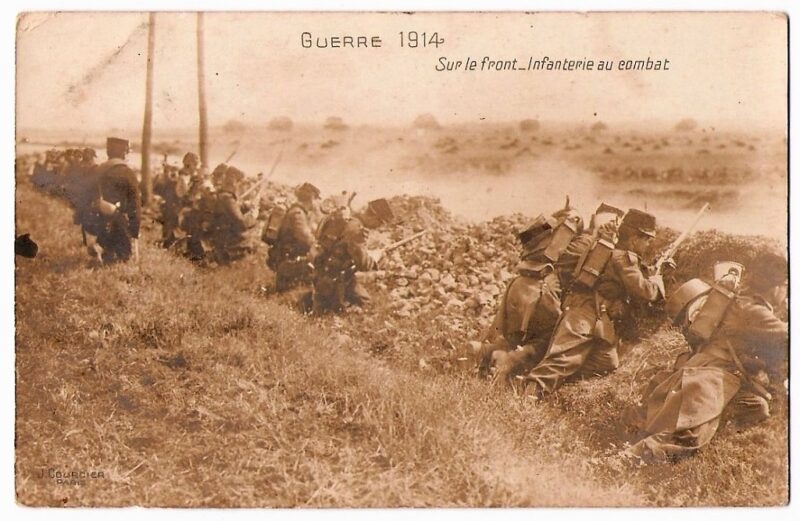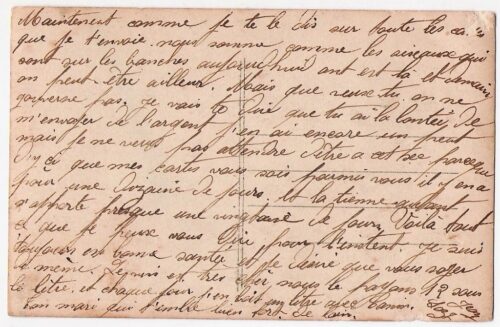
A lot to unpack with this card.
It’s the first of a long series from World War One.
First of all, it’s interesting to see that it says “War 1914.” It was the very beginning of the war. Obviously, people had no idea how long it was going to last. Back in 1914, everyone thought it was going to be a quick thing. It’s probably the case for every war, I’m afraid.
The trenches aren’t a thing yet. The French infantry is still wearing its original uniform with red pants and hats that had been the norm since the 19th Century.
As a reminder, the insistence from the Ministry of War in keeping this uniform for a war that was going to become the first real war of the industrial era proved to be a terrible mistake. It’s one of the main reasons for the terrible losses that the French Army sustained in the early days of the war. Red hats are perfect targets, clearly visible from the distance, among other things. It is sometimes hard to imagine how unprepared the French military was for this war.
The story written on the back is also fascinating and so instructive.
Some background information.
This is one of the many cards that Jean Sazy wrote to his wife Jeanne while he was a conscript on the front.
I’m not sure who he was exactly (my mom thinks he was a cousin to my grandfather), and I have no idea how these cards ended up in this collection of postcards that made their way to me. What’s interesting is that I also have some of the cards that Jeanne wrote to her husband, which makes me believe that he survived the war.
I tried to find online information about him. France has an official website that lists all the people who died while enlisted in the military. There are two Jean Sazy, but neither matches him. Actually, there is a “Jean-Baptiste Sazy” who was from the same area, but he died in 1914 (one of the many victims of the red hats, I’m afraid). Our Jean kept on writing well into the war.
Also, Sazy is a quite common last name in my home area. And Jean was one of the most common first names in France back then (the equivalent to John basically). So, obviously, not much information about him, if any, made it to the digital era (genealogy is sometimes helpful, but no luck on that side either).
A few years ago, the INSEE digitized its data about people who died in France after 1970, and I have indeed found a Jean Sazy, born in 1893 in a village close to my grandpa’s. He died in 1976, in another village not too far away. It could be him. No information about Jeanne, which could mean that she died before 1970.
His cards are sometimes hard to read. He often tried to fit as much as possible into one card. His texts also often spanned over several cards. An interesting reminder that space was an important constraint to the writing medium back in the day. Even more so, when you’re on the front, I assume.
Actually, it’s one of the main topics of this text, even though the middle part is sometimes a bit difficult to understand. His handwriting is not always easy to decipher. Plus, he’s not above making grammatical mistakes. And finally, he sometimes uses old expressions with meanings that are different from today.
Please note that it’s the final part of a longer letter. Unfortunately, I couldn’t find the beginning (sorting those is harder when you only have them at hand in digital form). Hopefully, it will show up at a later date.
Here is what it roughly says:
Now, as I tell you on every card I send you, we are like birds on branches. Today, we are here and tomorrow, we may be somewhere else. But you know, we’re not the ones governing.
I’ll tell you what, have the goodness to send me some money. I still have some but I don’t want to wait until I’m out, because only my cards that are provided to us (?) I have enough for about ten days. And yours (?) will last a fortnight.
That’s all I can tell you for now.
I am still in good health and I hope you all are healthy too.
Wine is very expensive, we pay 12 cents a liter, and every day we drink a liter with Lanois (?)Jean Sazy
Your husband, who sends you a big kiss from afar.
As you’ll see as I publish more cards from him, while he never really says anything of substance (soldiers weren’t allowed to tell much, and correspondence with the outside world was heavily censored), I think his cards are invaluable to teach us about the daily life of the soldiers, as well as their moods and more. His state of mind will change greatly as his time in the army goes from weeks to months to years, with all the deaths and horrors he witnessed).
Stay tuned for more.
If you enjoy these posts, you can thank me by subscribing to the site or my social media accounts (links are near the top right of the screen), you can also buy me a coffee.
Discover more from liminal web
Subscribe to get the latest posts sent to your email.


